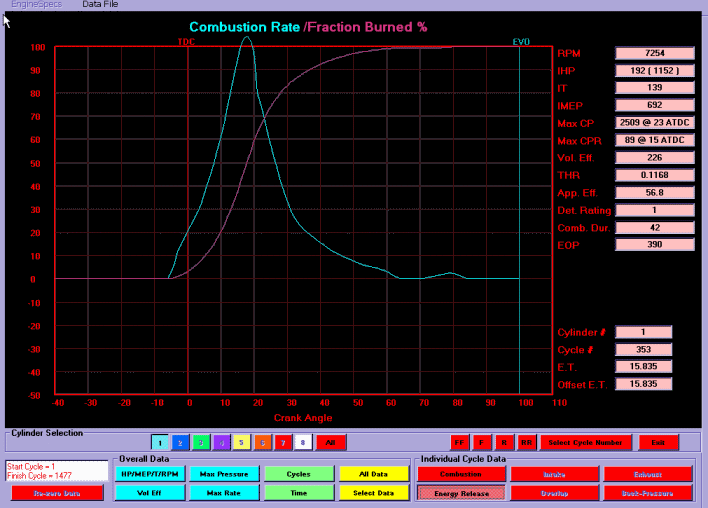|
Supercharged Engine Combustion Data
The following graphs display data collected from a supercharged engine operating on racing gas.
The data below represents only a small sample of the various data graphs produced after each dyno test. The software generates graphs summarizing the overall test in terms of HP, torque, combustion pressure, location of peak combustion pressure relative to TDC, volumetric efficiency etc. The software also generates graphs for each and every combustion and non combustion cycle during the test, displaying pressure vs. crank angle, air/fuel burn rates vs. crank angle and numerical data such as HP for each combustion cycle, peak combustion pressure/location, amount of energy released and how efficiently it was applied, etc.

Combustion Pressure
In the graph above the pink line shows the pressure that would have existed in cylinder 1 (combustion cycle 353) if the spark had not ignited the AF mixture. The blue line shows the actual pressure in cylinder 1 which was developed as a result of the AF mixture combustion. The purple line indicates the bulk AF combustion temperature in Celsius.
Peak combustion pressure is 2509 psi at 23 ATDC for this combustion cycle. Combustion is smooth as indicated by the smooth combustion trace with no detonation spikes. For this cycle 192 HP (139 ft.lb. of torque) was made by cylinder 1 at 7254 rpm. At the time of exhaust valve opening the pressure in the cylinder was 390 psi indicating the need for a strong valve train (exhaust side).For this cycle the combustion process is initiated far too late to maximize engine power as detailed in the graph below. Engine stresses are kept low with this late timing, but power is reduced and exhaust temperatures would be excessive.

Air Fuel (AF) Mixture Burn Rates
The burn rate or energy release rate of the combustion process for cylinder 1 (combustion cycle 353) is displayed above. The blue line indicates how quickly the AF mixture is burning relative to crank position and the pink line indicates the percentage of the AF mixture that has been combusted relative to crank position. For this combustion cycle only 3% of the AF mixture is combusted at TDC, 20 % at 10 ATDC, 60 % at 20 ATDC, 83 % at 30 ATDC and 100% near 60 ATDC. Since the engine is supercharged the combustion process occurs much more quickly than for a naturally aspirated engine with the same ignition point. Although the combustion process is fast it occurs too far ATDC to generate maximum power. Adjusting the ignition timing to a more appropriate value would result in significant increases in power for the same amount of boost. When timing adjustments are made the data logger data will indicate when the timing is correct and if any detonation is occurring.
It may appear that a simple timing adjustment is all that is required to optimize the engine but this is far from true. Adjusting the timing to maximize power can generate other issues such as detonation and "false detonation". Simply put false detonation is when the engine suffers catastrophic failure and the tuner assumes it blew up from detonation when in fact combustion was smooth and detonation did not occur. Supercharged engines can develop extremely high peak combustion pressures when properly adjusted and unless the engine is capable of supporting these pressures engine failure may occur without detonation occurring.
Referring to the combustion pressure graph at the top of the webpage, if the timing was adjusted to a more appropriate value the peak pressure would exceed 3000 psi, about 500 psi higher than generated with the existing timing. If it is known that a particular engine can withstand 3000 psi for instance (typically learned the hard way), then the boost can be increased substantially and the timing retarded appropriately using the data logger to ensure that the piston never sees more than 3000 psi over the range of engine speeds and boost levels. At very high boost levels additional cooling such as water injection may be required to lower combustion and exhaust temperatures. Although combustion will be extremely inefficient power will increase (disproportionately to boost) and engine stresses will be minimized. An extreme case of this type of tuning can be found in Super Stock pull-tractors operating at extreme boost levels on diesel fuel with water injection.

Combustion Pressure
In the graph above the ignition timing has been advanced somewhat from the combustion graph at the top of the web page. Although ignition timing is not quite correct output torque is 8% higher for about the same volumetric efficiency (boost level).

Maximum Combustion Pressure
Cycle to Cycle Variation
The upper graph indicates the peak combustion pressure (blue line) for each combustion cycle (cylinder 1) and the white line indicates engine rpm (right side scale). During the engine test peak combustion pressures fluctuated substantially from cycle to cycle averaging around 2400 psi but varying between 2000 and 2800 psi with one cycle having a peak of only 1600 psi. Obviously the combustion process was very unstable.
The lower graph indicates where peak combustion pressure occurred relative to TDC for each combustion cycle. The location of peak combustion pressure fluctuates substantially from cycle to cycle caused by the unstable combustion process. Engine adjustments leading to a more stable combustion process will generate more power with less stress on the engine. Well built engines would be stabilized at the high combustion pressures thereby generating more power per psi of boost.
Areas for Improvement (Combustion)
- Stabilize the combustion process throughout the entire test
- Equalize the combustion process in each cylinder
- Reduce cycle to cycle variation in the combustion process
- Maximize the number of good combustion cycles
- Further optimize the good combustion cycles to generate more torque
- Extend the rpm range where good combustion can occur
Return to Top
Last Updated by TFX Jan 27, 2023
Site design © Todd Paton Web Design |